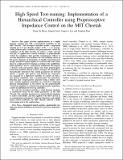| dc.contributor.author | Hyun, Dong Jin | |
| dc.contributor.author | Seok, Sang Ok | |
| dc.contributor.author | Lee, Jongwoo | |
| dc.contributor.author | Kim, Sangbae | |
| dc.date.accessioned | 2015-09-01T12:16:26Z | |
| dc.date.available | 2015-09-01T12:16:26Z | |
| dc.date.issued | 2014-08 | |
| dc.identifier.issn | 0278-3649 | |
| dc.identifier.issn | 1741-3176 | |
| dc.identifier.uri | http://hdl.handle.net/1721.1/98270 | |
| dc.description.abstract | This paper presents implementation of a highly dynamic running gait with a hierarchical controller on the MIT Cheetah. The developed controller enables high-speed running of up to 6 m/s (Froude number of Fr ≈ 7.34) incorporating proprioceptive feedback and programmable virtual leg compliance of the MIT Cheetah. To achieve a stable and fast trot gait, we applied three control strategies: (a) programmable virtual leg compliance that provides instantaneous reflexes to external disturbance and facilitates the self-stabilizing shown in the passive dynamics of locomotion; (b) tunable stance-trajectory design, intended to adjust impulse at each foot-end in the stance phase in a high speed trot-running according to the equilibrium-point hypothesis; and (c) a gait-pattern modulation that imposes a desired cyclic gait-pattern taking cues from proprioceptive TD feedback. Based on three strategies, the controller is hierarchically structured. The control parameters for forward speeds, a specific gait-pattern, and desired leg trajectories are managed by a high-level controller. It consists of both a gait-pattern modulator with proprioceptive leg TD detection and a leg-trajectory generator using a Bèzier curve and a tunable amplitude sinusoidal wave. Instead of employing physical spring/dampers in the robot’s leg, the programmable virtual leg compliance is realized using proprioceptive impedance control in individual low-level leg controllers.
To verify the developed controller, a robot dynamic simulator is constructed based on the model parameters of the MIT Cheetah. The controller parameters are tuned with the simulator to achieve self-stability, and then applied to the MIT Cheetah in an experimental environment. Using leg kinematics and applied motor current feedbacks, the MIT Cheetah achieved a stable trot-running gait in the sagittal plane. | en_US |
| dc.description.sponsorship | United States. Defense Advanced Research Projects Agency. Maximum Mobility and Manipulation (M3) Program | en_US |
| dc.language.iso | en_US | |
| dc.publisher | Sage Publications | en_US |
| dc.relation.isversionof | http://dx.doi.org/10.1177/0278364914532150 | en_US |
| dc.rights | Creative Commons Attribution-Noncommercial-Share Alike | en_US |
| dc.rights.uri | http://creativecommons.org/licenses/by-nc-sa/4.0/ | en_US |
| dc.source | Prof. Kim via Angie Locknar | en_US |
| dc.title | High speed trot-running: Implementation of a hierarchical controller using proprioceptive impedance control on the MIT Cheetah | en_US |
| dc.type | Article | en_US |
| dc.identifier.citation | Hyun, D. J., S. Seok, J. Lee, and S. Kim. “High Speed Trot-Running: Implementation of a Hierarchical Controller Using Proprioceptive Impedance Control on the MIT Cheetah.” The International Journal of Robotics Research 33, no. 11 (August 21, 2014): 1417–1445. | en_US |
| dc.contributor.department | Massachusetts Institute of Technology. Department of Mechanical Engineering | en_US |
| dc.contributor.mitauthor | Kim, Sangbae | en_US |
| dc.contributor.mitauthor | Hyun, Dong Jin | en_US |
| dc.contributor.mitauthor | Seok, Sang Ok | en_US |
| dc.contributor.mitauthor | Lee, Jongwoo | en_US |
| dc.relation.journal | The International Journal of Robotics Research | en_US |
| dc.eprint.version | Author's final manuscript | en_US |
| dc.type.uri | http://purl.org/eprint/type/JournalArticle | en_US |
| eprint.status | http://purl.org/eprint/status/PeerReviewed | en_US |
| dspace.orderedauthors | Hyun, D. J.; Seok, S.; Lee, J.; Kim, S. | en_US |
| dc.identifier.orcid | https://orcid.org/0000-0002-0218-6801 | |
| mit.license | OPEN_ACCESS_POLICY | en_US |
| mit.metadata.status | Complete | |
